Locoweed is a common name in North America for any plant that produces swainsonine, an alkaloid harmful to livestock. Worldwide, swainsonine is produced by a small number of species, most of them in three genera of the flowering plant family Fabaceae: Oxytropis and Astragalus in North America, and Swainsona in Australia. The term locoweed usually refers only to the North American species of Oxytropis and Astragalus, but this article includes the other species as well. Some references may incorrectly list Datura as locoweed.

The insects of the beetle family Chrysomelidae are commonly known as leaf beetles, and include over 37,000 species in more than 2,500 genera, making up one of the largest and most commonly encountered of all beetle families. Numerous subfamilies are recognized, but the precise taxonomy and systematics are likely to change with ongoing research.

Astragalus is a large genus of over 3,000 species of herbs and small shrubs, belonging to the legume family Fabaceae and the subfamily Faboideae. It is the largest genus of plants in terms of described species. The genus is native to temperate regions of the Northern Hemisphere. Common names include milkvetch, locoweed and goat's-thorn. Some pale-flowered vetches are similar in appearance, but they are more vine-like than Astragalus.
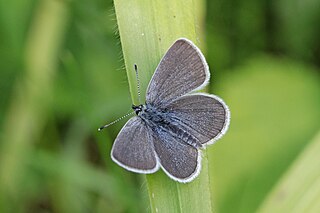
The small blue is a Palearctic butterfly in the family Lycaenidae. Despite its common name, it is not particularly blue. The male has some bluish suffusion at the base of its upper wings but is mostly dark brown like the female. The species can live in colonies of up to several hundred and in its caterpillar stage is cannibalistic.

Astragalus trichopodus is a species of legume known by the common name Santa Barbara milk vetch. It is native to southern California and Baja California, where it grows in several types of open habitat, including in the Transverse Ranges and Mojave Desert.

Zizina labradus, the common grass blue, grass blue, or clover blue, is a small Australian butterfly of the family Lycaenidae.
Astragalus crotalariae is a species of milkvetch known by the common name Salton milkvetch. It is native to the Colorado Desert in California and other Sonoran Deserts in Arizona and northern Mexico. It grows in desert scrub habitat, including the Salton Sink in the Coachella Valley.

Etiella behrii is a species of moth of the family Pyralidae, occurring sporadically but when present considered a serious pest of agricultural crops throughout parts of Australia.
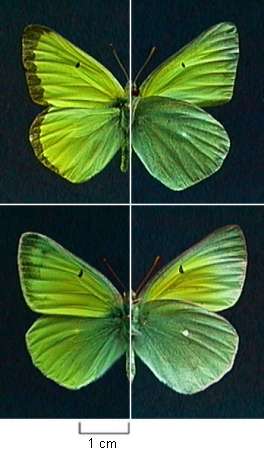
Colias alexandra, the Queen Alexandra's sulphur, Alexandra sulphur, or ultraviolet sulfur, is a butterfly in the family Pieridae found in western North America. Its range includes Alaska to the Northwest Territories and south to Arizona and New Mexico.
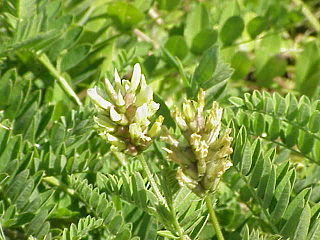
Astragalus cicer, the chickpea milkvetch, chick-pea milk-vetch or cicer milkvetch, is a perennial flowering plant native to Eastern Europe, popularized and subsequently transported to areas in Southern Europe, North America, and South America. It produces pods that resemble those of chickpeas. Its flowers are usually of pale yellow tint, and attract bumble or European honey bees for pollination. Growth often exceeds 0.6 meters, up to a height of 1 meter in length.
Fundella pellucens, the Caribbean pod borer, is a species of snout moth in the genus Fundella. It was described by Zeller in 1848.

Astragalus microcymbus is a species of flowering plant in the legume family known by the common name skiff milkvetch. It is endemic to Colorado in the United States, where it is known from Gunnison County and the edge of Saguache County. It was discovered in 1945 by Rupert Barneby, a British botanist. Currently, skiff milkvetch is experiencing population declines and is listed as a Tier 1 species in the Rare Plant Addendum to the Colorado State Wildlife Action Plan.
Pima albiplagiatella, the white-edged pima moth or beach pea borer, is a species of snout moth described by Alpheus Spring Packard in 1874. It is found in the south-western United States, as well as Colorado, Oregon, Washington, Manitoba, New York and Pennsylvania.
Astragalus wetherillii is a species of flowering plant in the legume family known by the common name Wetherill's milkvetch. It is native to Colorado and Utah in the United States.

Astragalus mollissimus is a perennial plant in the legume family (Fabaceae) found in the Colorado Plateau and Canyonlands region of the southwestern United States.

Acanthoscelides obtectus, the bean weevil, is a species of bruchid beetle. The species was described in 1831 by Thomas Say.
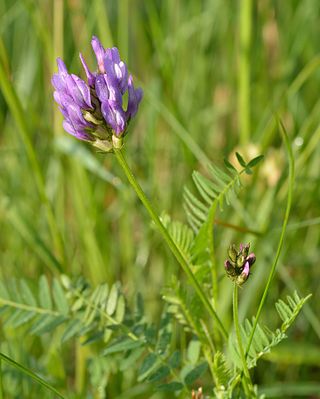
Astragalus danicus, known as purple milk-vetch, is a species of flowering plant in the family Fabaceae (legumes), which is native to Europe.
Polyommatus (Agrodiaetus) ninae, or Nina's blue, is a butterfly of the family Lycaenidae described by Walter Forster in 1956. It is found in Armenia, Azerbaijan, Georgia, eastern Turkey, and northern Iran (Kurdistan).

Astragalus crassicarpus, known as ground plum or buffalo plum, is a perennial species of flowering plant in the legume family, Fabaceae, native to North America. It was described in 1813. The fruit is edible and was used by Native Americans as food and horse medicine. It is a host of afranius duskywing larvae. It is also known as groundplum milkvetch and pomme de prairie.
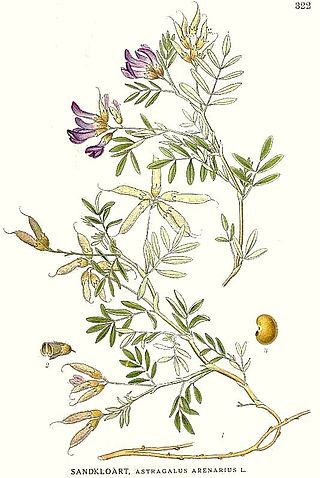
Astragalus arenarius, the sand milk-vetch or sand milkvetch, is a species of milkvetch mostly found in Central and Eastern Europe, with populations in Russia stretching perhaps as far as the Urals, and a few instances in Sweden, Finland, and perhaps Denmark. The center of diversity appears to be in Central Russia. Its chromosome number is 2n = 16.













